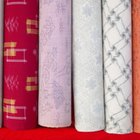
Walking into a fabric store to look for veil material can be overwhelming. The different kinds of veiling can be difficult to tell apart, making deciding what material will work best a challenge. Understanding the difference between two common veiling materials, illusion and tulle, can help you choose the best fabric for your needs.
Identification
Illusion veiling is a type of tulle or netting with extremely fine, diamond-shaped holes. It is a light material that drapes well and still holds a shape, making it a common choice for bridal veils.
Tulle is a lightweight woven netting that is often starched to give it more body. The size of the holes in tulle can vary depending on the material and the intended usage.
Usage
Illusion is almost exclusively used for bridal and other veils, due to its lightness and drape. Varieties of tulle are used for short veils, dance costumes, crinolines and other items that require a stiffer fabric, such as decorations and even hair bows.
Types
Both kinds of veiling are available in many different colors and lengths. Most illusion veiling material is available in widths up to 108" and in varying shades of white and ivory, to coordinate with a bridal gown. Tulle is available in a greater range of shades than illusion veiling, with brights and pastels among the color options.
Considerations
When deciding between tulle and illusion veiling, take into consideration the stiffness of the material and the drape you desire for your project. Illusion veiling, while it has body, will have more drape and flow than starched tulle. On the other hand, if your project requires fullness, the stiffer tulle fabric may be a better option.
Fabrics
Illusion veiling is primarily made of polyester, while tulle can be made from both synthetic and natural fibers, such as rayon, nylon, cotton and silk. Note that silk tulle is dramatically different from the traditional tulle; instead of being full and stiff, it is soft and flowing, even more so than illusion veiling. Silk tulle is used in a similar fashion to illusion veiling and should not be confused with nylon or polyester tulle.
Related Articles

How to Make a Tutu Stick Out

What Fabric Makes Dresses Poofy?

Types of Indian Fabric

Different Kinds of Chiffon Fabric

Decorating Ideas for a Pavilion for a ...

What Is Synthetic Hair Made Of?

Linen vs. Wool Blazer
How to Make a Baby Tutu

How to Crochet a Wedding Veil

Polyester Vs. Silk Dresses

The Best Formal Dress Style for Pear ...

What Is Artificial Silk?

The Advantages & Disadvantages of Woven ...

How to Decorate Bridal Bouquets With ...

Types of Synthetic Hair

Tulle Wedding Decoration Ideas

How to Remove Body Odor From Silk & ...

Steaming a Chiffon Wedding Dress

What Do Chinese Women Wear?

How to Make an Edge for a Bridal Veil
References
Writer Bio
Christine Meyer has been writing professionally since 1995. Holding a Bachelor of Arts in music from Taylor University, a CELTA from the University of Cambridge ESOL, and a CBA in marketing from IBMEC Rio de Janeiro, Meyer has experience in a variety of fields. Her articles have been published in newspapers and on sites such as eHow.com.
Photo Credits
Brides Veil image by Kevin Cooke from Fotolia.com